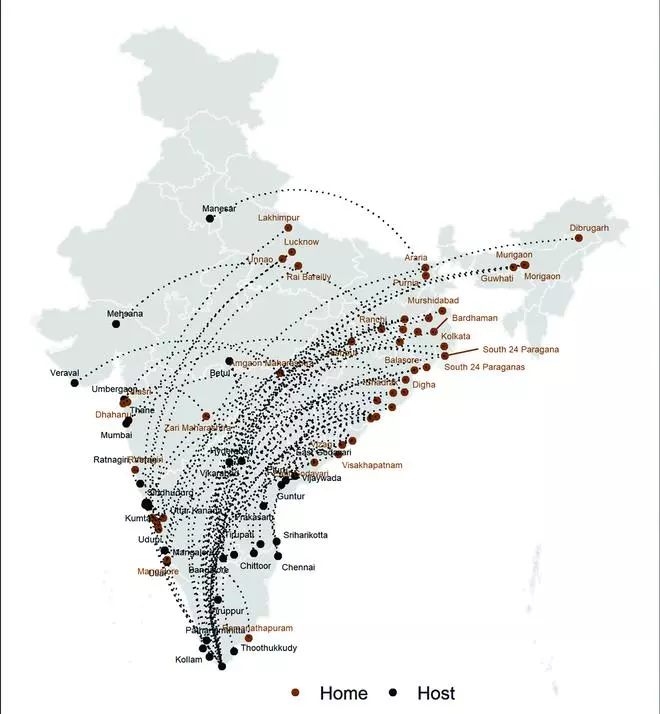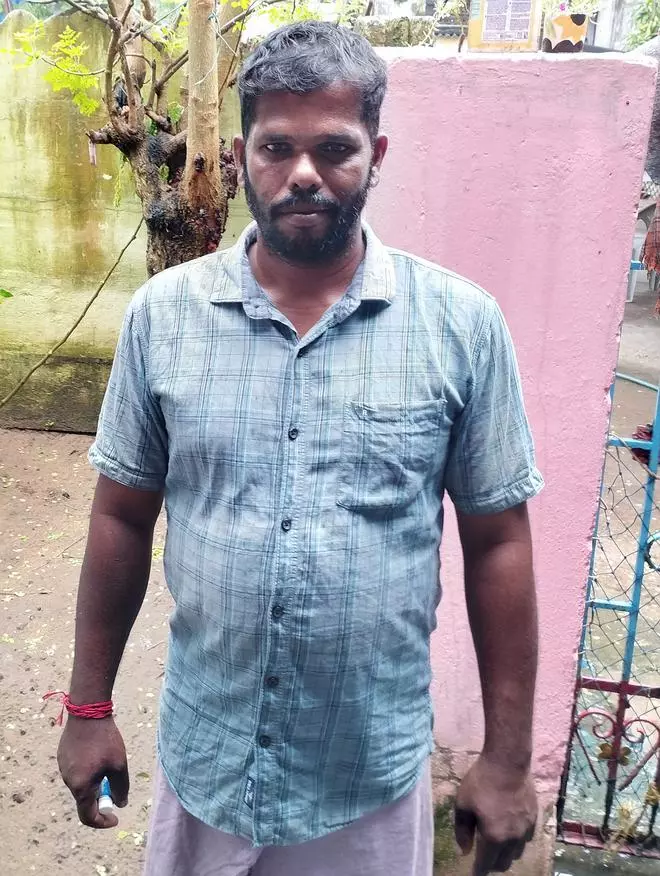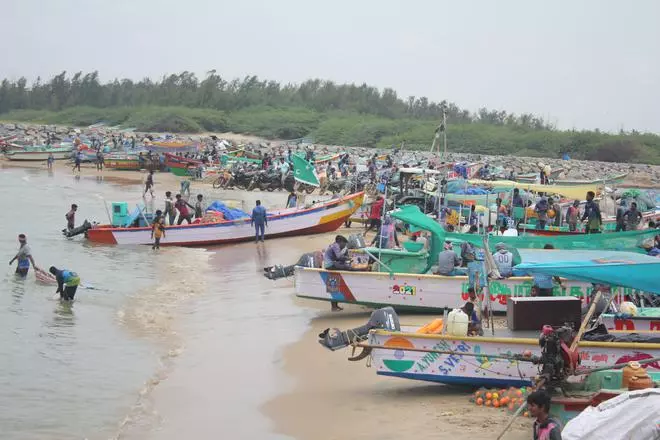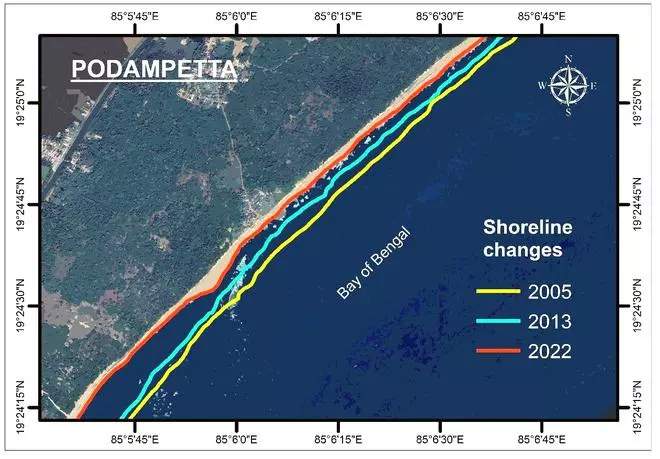Artisanal fishers minimized to doing work as labourers on trawlers in faraway spots
Dwindling catch, rampant erosion, and an indifferent administration have rendered them invisible.
Ch. Potudu, 48, an artisanal fisher from the standard Nolia fishing caste, took up sea fishing at the age of 13 and mastered it around the up coming 20 many years. His livelihood depended entirely on understanding how to practise his craft, discovering from it every working day. But the very last two decades have witnessed a big shift in the fortunes of the Nolia neighborhood as the sea started to generate considerably less and significantly less. With couple other abilities or selections to make a living in his seaside village of Podampeta, in Ganjam district of Odisha, Potudu migrated all the way to the west coastline in look for of function.
Question of id
This was not just a physical journey but a person of identification: a very skilled artisanal fisher with remarkable understanding of the sea was minimized to unskilled labourer. For the very last 15 yrs, he has been sorting fish, cleansing the deck, and doing other menial employment on mechanised trawlers in harbours in Maharashtra, Gujarat, and Kerala. He visits his relatives the moment a yr. “A trawler is no put to sleep or take in or reside in, but I see no other way to continue to be afloat on life’s limitless sorrows,” explained Potudu.
This is a fate shared by many tiny-scale fishing people from the eastern States of Odisha, Andhra Pradesh, and Tamil Nadu.
Bharathi, 35, belongs to the Pattinavar fishing caste that traces an historic lineage and is a resident of Nambiyar Nagar, 1 of the prominent head-villages of this community, in Nagapattinam district of Tamil Nadu. She shared with us the contours of her family’s hopes: “The boat was our aspiration. My spouse purchased a new ‘fibre boat’ making use of a bank loan I took from a microfinance business. Just about every month, he needs to convey residence a revenue of at least Rs.10,000 from fishing. Only then can I repay the financial loan EMI [equated monthly instalment] and hope to operate my relatives. In the past couple of decades, gas selling prices have risen so sharply that even if we do catch the number of fish still left in the sea, there is barely something still left as a gain.”
In a sort of desperate consolation, Bharathi added: “I’m not the only one particular. While I couldn’t pay out service fees for my daughter this 12 months, my neighbours have not compensated university charges for the earlier two years. For every person in this village, lifetime is a struggle .Some even choose financial loans from their neighbours to pay out again their EMIs.”
Seasonal migration to work as trawler labourers is now a typical exercise among the the Pattinavars of Nambiyar Nagar. Bharathi’s more youthful brother far too migrated to Singapore for a job to aid his loved ones.
Resource degradation
As with India’s agrarian labour drive, resource degradation is a key cause for distress migration among the fishers. Across the east coast, substantial mechanisation, declines in catch, and increasing operational and dwelling expenses have pushed little-scale fishers, specifically artisanal fishers, in the direction of financial vulnerability and structural exploitation. Ironically, a lot of of them seek out employment in the pretty mechanised sector that is linked to the degradation of maritime assets in the initially place.

An approximated 450 million Indians migrate to considerably off areas for work, and this involves maritime fishers and occasionally their family members. Though the greater part of migrant fishers are mainly intra- and inter-Condition migrants, numerous go overseas, predominantly West Asia, Singapore, Malaysia, and Indonesia. The exact extent of migration from the coastal parts of the country is unidentified, but the trend is significant and clear to any one doing work with fishing communities. Advanced result in things spark off these kinds of migration, which is not necessarily healthier in its cumulative effects as we identified in the training course of our get the job done along the east coast.
When furnishing relief assist to stranded migrant fishers in the course of the 2020 COVID-19 lockdown, Dakshin Basis acquired phone calls for assistance from throughout harbours on the west coast. The migration map (Determine 1) reveals dwelling States and host States where by migrants were being stranded.

| Photograph Credit: Lakshmi
Sathyakeerthi, a Pattinavar fisher from Chinnakudi fishing village in Mayiladuthurai district in Tamil Nadu, migrated to Singapore, a region well-known for its stringent labour regulations but which has failed to protect staff like him. Leaving his house Point out in 2004, the 19-year-outdated took a occupation in the shipbuilding industry. He imagined that he would in good shape simply within just the familiarity of an allied maritime sector but was offered the work of portray tanks fitted inside the significant ships.
“Within a handful of days, my entire body began reacting to the paint’s chemical compounds. One working day, when I was portray the interiors of the ship’s tanks, I out of the blue felt seriously breathless. Someway I managed to climb out of the tanks. I was out of motion for a 7 days with significant fever. All this was known to my supervisors,” claimed Sathyakeerthi.
At the top of his fever, when Sathyakeerthi preferred to go to medical center, the site supervisor replied, “If you are heading to die, die below.” As his health and fitness deteriorated and respiratory bought hard, he began worrying about his survival. “I formally noted my health and fitness problem to the company’s administration without realizing that this would be the end of my career in this article.” The business unsuccessful to be certain his office safety or present redress immediately after his illness.
Sathyakeerthi laboured for a few a lot more decades in Singapore, haunted by the prospect of letting down his loved ones again dwelling. In 2007, he returned to Chinnakudi, burdened with actual physical conditions and the financial debt from spending an agent to get the Singapore job. He has because identified respite in small-scale fishing, albeit from a depleted sea, which however feeds his household and has restored his self-respect.
The condition of inner migrants from fishing communities arrived to gentle throughout the very first COVID-19 lockdown’s relief endeavours. Apart from their poor doing work and dwelling problems, reduction workers confronted a significant trouble in contacting and connecting migrant fishers to their people, or to reduction steps and guidance. Even fisher leaders across the east coastline struggled to achieve folks who experienced migrated from their village. The benefit of keeping data of migrant fishers became clear immediately after the lockdown.
In the 1st month of the lockdown, all-around 2,000 fishers from modest-scale fishing communities of Andhra Pradesh have been stranded at the Veraval harbour in Gujarat, with out ample consuming water, food items, or lodging. Nonetheless, speaking to migrant staff who returned to the west coast for function right after the lockdowns have been lifted nearly two years afterwards, we comprehended that their ailments were being not any superior through “normal” periods.
No enough safeguards
In the absence of any committed legislation or plan for migrant fishers and the peculiar mother nature of their function on vessels and at sea, guaranteeing their safety at get the job done escapes the attention of federal government departments.
The Labour and Fisheries departments set the onus on each other when it comes to issues pertaining to migrant fishers. The ambiguity in excess of definitional issues has meant that this constituency slips by condition information and safeguards, rendering them doubly susceptible, as staff and as fishers.
Authorities initiatives like e-Shram presumably attempt to proper this lapse. There are practically no databases of migrant fishers, and the authors have been element of a task that set out to make neighborhood databases in 15 villages of Nagapattinam and Mayiladuthurai districts in Tamil Nadu, and Ganjam district in Odisha, all of which experience intensive migration.

“These databases are not only valuable for fisher migrants, they play a significant purpose for non-fishing migrants also. We confronted so many serious difficulties throughout the lockdown to even access our possess people” explained Sanjukta Pradhan, Sarpanch of Pallibandha Gram Panchayat of Ganjam district of Odisha.
No dedicated Point out economical outlays have been allotted for making decentralised databases at the Point out or district level. The foreseeable future of these kinds of fishworker labour data, which even the 2021 NITI Aayog draft migrant employee coverage advocated, is dependent on the involvement of civil society organisations and the participation of conventional institutions of fishing communities and gram panchayats.
The ‘push factor’
Though these submit-pandemic endeavours to make migration protected and safe are important, the depth of the “push factor” grows in energy. Districts like Ganjam have turn into the recently famous web pages for swift sea erosion, in addition to a lot more entrenched issues such as declining fish capture and increased indebtedness.
With robust cyclones, rising sea amounts, and spectacular shoreline alterations from port and other building, coastal erosion has turn into a effective press factor in villages like Podampeta which have viewed lots of waves of displacement.
Podampeta has found its shoreline shrink substantially to an extent wherever just about every year the sea swallows rows upon rows of brightly tiled houses, eroding any hope amid its final remaining residents.

| Picture Credit score: P. Sivaranjan
This devastation started off in 2007. By 2012, 110 homes in the freshly settled web-site called “New Podampeta” had been also taken by the sea. When their seashore commons vanished, the conventional fishers discovered by themselves acquiring to pay out hire to store their boats and nets since the only offered house close to the sea was private farmland. These every day rents increase to increasing fishing enter expenses.
Sathyakeerthi’s migration tale ended on a good take note. He managed to return house to Chinnakudi village, market his wife’s jewelry to spend his financial debt, and he continues fishing in his tiny boat, just controlling to remain afloat.
Not all east coastline fishers have even the assurance of the existence of their houses when they return. It appears that when erosion sets in, then hardships accrete, adding bit-by-little bit to the migrant fisher’s daily life, or as Potudu from Podampeta explained it, a virtual sea of sorrows.
The authors are with Dakshin Foundation, a non-financial gain organisation operating with marine fishers of India. The views expressed in this article are private.
The Crux
- The previous two a long time have seen a key change in the fortunes of the fisher local community as the sea commenced to produce considerably less and considerably less.
- With few other capabilities or possibilities to make a living, fishers migrate all the way to the west coast in research of operate and end up as guide labourers.
- This is not just a bodily journey but a person of identity: from a hugely skilled artisanal fisher with remarkable know-how of the sea to an unskilled labourer.
- As with India’s agrarian labour drive, resource degradation is a major purpose for distress migration among fishers.
- In the absence of any dedicated legislation or plan for migrant fishers and the peculiar character of their work on vessels and at sea, guaranteeing their security at perform escapes the attention of government departments.

